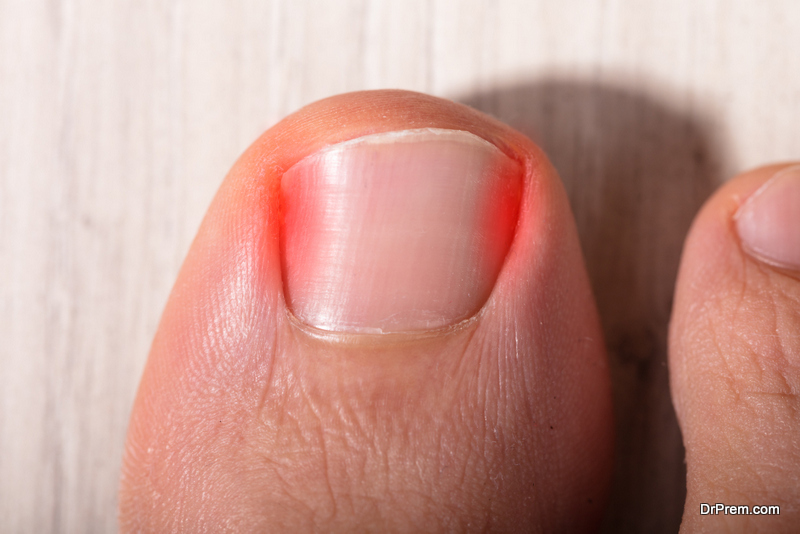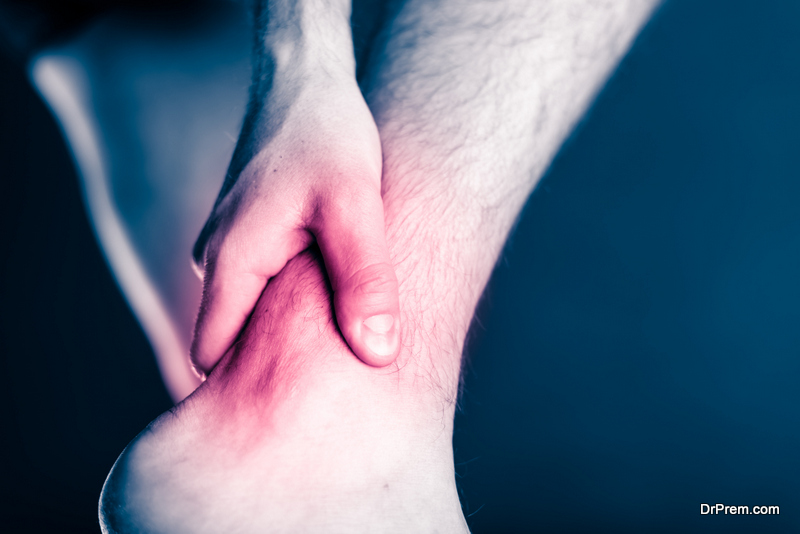Our feet take a major beating. After all, their responsible for carrying the weight of our bodies, plus protecting us against rough surfaces of various temperatures. If you work on your feet all day long, you’re all too familiar with the toll it takes on your body. Certain people are more susceptible to common foot conditions based on their health and activity level. Keep reading to discover 5 of the most common foot issues, prevention, and treatment options.
1. Ingrown Toenails

Ingrown Toenails
The bottom of your feet isn’t the only areas prone to injury or ailments. Ingrown toenails are fairly common and occur when your nail grows into the nail groove, causing pain and discomfort. The first sign of an ingrown toenail is pain in the area. This is likely worse when wearing shoes or applying pressure on the area while exercising, running, or dancing. You may also experience redness, swelling, or even drainage from the area, which is a sign of an infection.
Tightly fitted shoes can not only irritate ingrown toenails but might even cause them. Trauma to the toenail or accidentally cutting it too short can also cause the nail to grow in crooked or unnaturally. But even when you’re extra-careful not to injure your toenails or clip them too short, genetics may work against you. If your parents or grandparents suffered from ingrown toenails, you’re at greater risk for developing the condition as well.
2. Athlete’s Foot
Athlete’s foot is common among gym-goers and those who use a public pool or shower. That’s because athlete’s foot is a fungal infection that is easily spread through contact of the skin. It also thrives on damp, warm areas. Symptoms include a red rash that causes irritation and significant itching and discomfort. The rash generally starts between a person’s toes but can spread quickly to the bottom of the feet and heels.
Some people notice cracking, peeling, and blistering during an outbreak. Treatment of athlete’s foot includes keeping your feet clean and dry. Wearing closed shoes during an athlete’s foot breakout is not recommended. This seals in the fungus and gives it warmth and moisture to grow. Spray, powder, and antifungal lotions can help ease athlete’s foot symptoms and kill the fungus. Oral, prescription medications are sometimes needed if at-home treatment is ineffective.
3. Plantar Fasciitis

If you’re experiencing heel pain, chances are it’s plantar fasciitis. In fact, this condition is the main cause of heel pain in most patients. A ligament on the bottom of your foot, known as the plantar fascia, gives this condition its name. When the ligament becomes inflamed, it causes extreme pain in the heel. Plantar fasciitis is aggravated by certain activities and is often worse in the morning, when your body is tight following sleep. Plantar fasciitis is most commonly treated at home using several remedies. Anti-inflammatory and pain reducing medications can help ease some discomfort during a flare-up. If you’re foot is aggravated, try resting, elevating, and icing the area. It’s important that plantar fasciitis sufferers practice plenty of stretching.
This prevents the ligament from tightening up too much. Try stretching after you wake up, before any physical activity, and throughout the day. Some doctors recommend a brace that’s worn at night and keeps a patient’s foot flexed, stretching the plantar fascia ligament. There are also specifically designed shoes that can help reduce discomfort. See more options here. If your condition worsens, steroid shots may be needed. Because there is no known cause for plantar fasciitis, it’s more about prevention and treatment to help you continue living a full, active life.
4. Bunions
Bunions are a common abnormality of the foot where a large bump develops on the big toe. Women are more susceptible to the disorder than men. Causes range from genetics to wearing tight or narrow shoes that press on the area where your foot bone meets your toes (metatarsophalangeal). Signs you have a bunion include Pain in your big toe when walking, difficult moving your big toe, tenderness, and a visible bump or inflammation.
The best way to prevent the development of a bunion is wearing properly fitted shoes. Shoes that are too tight or wearing high heels too often can cause and aggravate bunions. During a flare up, ice can help reduce swelling and pain. Shoe pads and specially made shoes can help reduce pressure applied to the affected area. These inserts may also help correct the position of the big toe. Persistent or chronic bunions may require surgery to remove.
5. Blisters and Corns

Blisters and Corns
Blisters and corns are relatively common and while inconvenient and painful, they aren’t a serious condition. Corns are your body’s way of preventing the development of blisters. Both corns and blisters first appear on the soles of the feet, ball, or toes. The skin in this area thickens over time, in an attempt to protect your body. Irritation from ill-fitting shoes, friction, or excessive activity can cause corns to develop. Sweating leads to skin irritation and the development of corns and blisters as well. Consider corns as a warning sign that blisters aren’t too far behind.
You can treat them by purchasing better shoes or changing the type of activity you’re doing. Corn plasters are also sold over the counter. Corn plasters are foam cushions shaped like a ring. This helps loosen the calloused skin and moistens the area, allowing the corn to peel off. If this treatment approach doesn’t work, a blister may eventually form. Blisters are fluid filled sacs that should be left to heal on their own. Popping or draining blisters can lead to infection and prolong the healing process, which takes between 3 and 7 days. Once the blister naturally bursts and drains, avoid peeling off the excess skin. The best way to handle both corns and blisters is to wear proper footwear and avoid movements or activities that irritate the skin.
To sum up
We don’t always take the best care of our feet — assuming they’ll continue to sustain whatever wear and tear we put them through. And while they’re resilient, problems can arise. Being mindful of your footwear and practicing good hygiene are two steps in the right direction to help prevent these common foot issues from developing.




